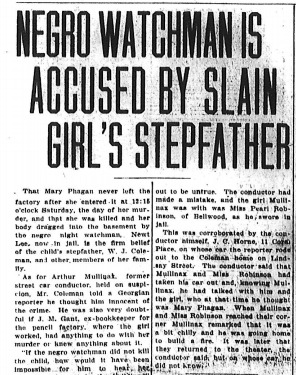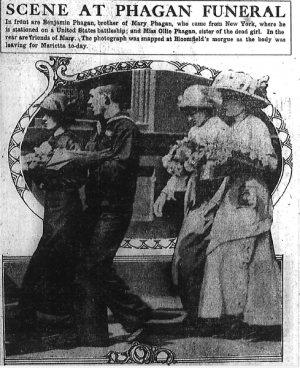 Another in our series of new transcriptions of contemporary articles on the Leo Frank case.
Another in our series of new transcriptions of contemporary articles on the Leo Frank case.
Atlanta Georgian
Tuesday, April 29th, 1913
That Mary Phagan never left the factory after she entered it at 12:15 o’clock Saturday, the day of her murder, and that she was killed and her body dragged into the basement by the negro night watchman, Newt Lee, now in jail, is the firm belief of the child’s stepfather, W. J. Coleman, and other members of her family.
As for Arthur Mullinax, former street car conductor, held on suspicion, Mr. Coleman told a Georgian reporter he thought him innocent of the crime. He was also very doubtful if J. M. Gant [sic], ex-bookkeeper for the pencil factory, where the girl worked, had anything to do with her murder or knew anything about it.
“If the negro watchman did not kill the child, how would it have been impossible for him to hear her screams going on in the building?” he asked. “A livery stable man next door heard them, and it would have been much easier for the watchman to. If the black did not do it himself, then he must have known something about it, and who the person was who did it.”
Outlines Theory of Murder.

Then, in broken tones, for he had just returned from making all arrangements for taking the girl’s body to Marietta, Ga., to be buried, he outlined his idea of how she met her death.
“When Mary turned from the window after receiving her money,” he said, “I think that, instead of going directly out, she went to the dressing room, perhaps for a drink of water, as one of the notes found said. Superintendent Frank, missing her when he came out and supposing she had left the building, locked her in. The negro watchman must have seen her go into the dressing room, and a little later seized her and gagged her.”
Later developments in the story go to show that the spot where the child’s hair was found caught on a steel lathe was not the scene of her struggle with her assailant. In the dressing room, it was said by a member of her family, there were plain evidences that the attack was made. She was also gagged in the room, for a strip of her new lavender dress was cut off from the front and bound around her mouth to keep her from screaming.
Ribbon Found Near Boiler.
Another bit of evidence, it was said, that went to throw added suspicion on the black was a bow of the child’s blue ribbon and a handkerchief found down near the boiler, where he constantly stayed.
“The negro evidently kept the child in the factory all day,” Mr. Coleman said, “and was afraid to attack her until midnight for fear she would scream or somebody would come. He may or may not have knocked her senseless from the first, or he may have tied her. I do not know, but when Gant entered the shop it is more than likely that he knew nothing of the girl’s presence there and simply went up and got his shoes, as he said, and went out again.
“All this about Mary having been seen on the street at midnight or at any other time after 12 o’clock in the day I do not think can be true. I believe she remained all day in the building. After the negro did the work, he was afraid to leave or not to notify the police, which would make appearances worse for him. Therefore, he called the officers.”
Now Clears Mullinax.
Mr. Coleman said he had at first given credence to a report that Mary had come home at 6 o’clock Saturday afternoon, and that Mullinax meeting her as she got off of the car, had taken her back to town with him. This report, Mr. Coleman said, turned out to be untrue. The conductor had made a mistake, and the girl Mullinax was with was Miss Pearl Robinson, of Bellwood, as he swore in jail.
This was corroborated by the conductor himself, J. C. Horne, 11 Coral Place, on whose car the reporter rode out to the Coleman home on Lindsay Street. The conductor said that Mullinax and Miss Robinson had taken his car out and, knowing Mullinax, he had talked with him and the girl, who at that time he thought was Mary Phagan. When Mullinax and Miss Robinson reached their corner Mullinax remarked that it was a bit chilly and he was going home to build a fire. It was later that they returned to the theater, the conductor said, but on whose car he did not know.
* * *
Atlanta Georgian, April 29th 1913, “Negro Watchman is Accused by Slain Girl’s Stepfather,” Leo Frank case newspaper article series (Original PDF)